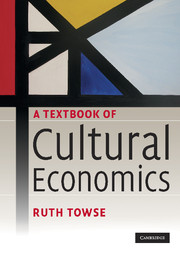Book contents
- Frontmatter
- Contents
- List of figures
- List of tables
- List of boxes
- List of abbreviations
- Preface
- Part I General issues in cultural economics
- Part II The ‘traditional’ economics of the arts and heritage
- Part III Artists' labour markets and copyright
- Introduction
- 11 Economics of artists' labour markets: theories
- 12 Economics of artists' labour markets: empirical research
- 13 Economics of copyright
- Part IV The creative industries
- Part V Conclusion and exercises and problems
- References
- Index
11 - Economics of artists' labour markets: theories
- Frontmatter
- Contents
- List of figures
- List of tables
- List of boxes
- List of abbreviations
- Preface
- Part I General issues in cultural economics
- Part II The ‘traditional’ economics of the arts and heritage
- Part III Artists' labour markets and copyright
- Introduction
- 11 Economics of artists' labour markets: theories
- 12 Economics of artists' labour markets: empirical research
- 13 Economics of copyright
- Part IV The creative industries
- Part V Conclusion and exercises and problems
- References
- Index
Summary
The term ‘labour market’ refers to the supply and demand for hours of work by workers who have similar skills; there is a labour market for hairdressers, therefore, and a labour market for electricians. In the arts, there is a labour market for classically trained singers, one for actors and another for potters. As in goods markets, what differentiates one market from another is the extent to which there is substitutability – in this case, between one type of worker and another. The ability to do certain types of work distinguishes specific occupations.
Labour markets
Supply and demand work in labour markets as they do in goods markets. Workers offer hours of work at various rates of pay; the higher the wage rate, the more hours they are in general willing to work. On the demand side of the market, employers demand more hours of work as wage rates fall. The wage rate is the price per hour of labour. At the equilibrium wage rate, the number of hours supplied and demanded is equal. This can also represent the level of employment in terms of the supply and demand for the number of workers in a labour market.
- Type
- Chapter
- Information
- A Textbook of Cultural Economics , pp. 293 - 318Publisher: Cambridge University PressPrint publication year: 2010
- 2
- Cited by



